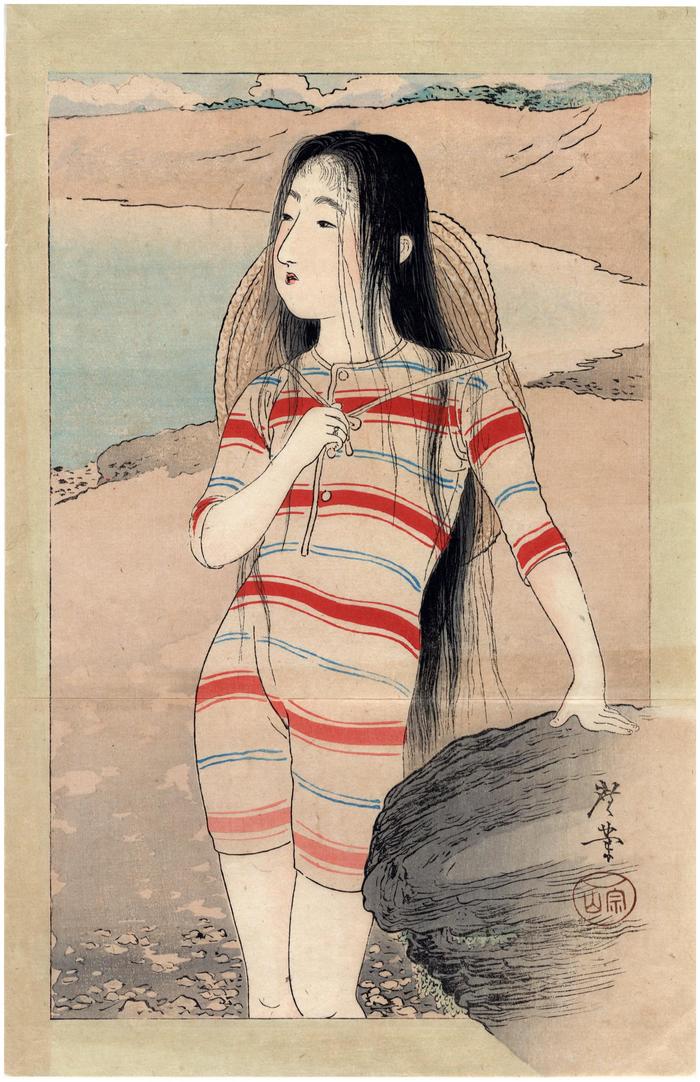Terazaki Kōgyō (寺崎広業) (artist 1866 – 1919)
Bathing Beauty - 美人の海水浴
1903
7.5 in x 12.188 in (Overall dimensions) Japanese color woodblock print
Signed: Kōgyō (廣業)
Seal: Sozan
Harvard Art Museums
Art Gallery of Greater Victoria
The National Museum of Asian Art
Centre Céramique de Maastricht
National Library of Australia
Kruizenga Art Museum, Hope College, Holland, Michigan
Honolulu Museum of Art The National Library of Australia wrote of this piece: "The print was produced as a kuchie frontispiece in a literary magazine titled Bungei kurabu, dai 9-kan, dai 10-gō. Not created to accompany a particular literary piece in the issue."
****
When Donatello revealed his sculpture of a naked young man as David in the early 15th century it shocked his contemporaries not only in the art world, but in his world in general. Its naturalism was unlike anything that had been seen since ancient Rome or Greece and it was obviously the precursor to Michelangelo's David done about 70 to 80 years later.
One has to wonder if Kōgyō had seen reproductions of these stunning European sculptures when he posed his model at the seaside wearing a one-piece bathing suit. He must have. Of course, here instead of a young man Kōgyō substitutes a young woman posing somewhere along an unidentifiable shoreline. (The background might in fact have simply been a stage-prop like studio backdrop.) But that does not take away from the similarities between this image in woodblock print form and those of its three-dimensional European precedents. Moreover, this image, while not naked, must have been just as shocking to its contemporaries in early 20th century Japan as those of Donatello and Michelangelo had been in 15th and 16th century Florence.
How else is Kōgyō's bathing beauty like the David sculptures? It is in the pose, the contrapposto, especially in the placement of the hips and legs. This woman is resting her weight on her straightened left leg, leaving her right knee free to thrust forward in a perfectly relaxed manner. This was the secret to naturalism that Donatello rediscovered and Michelangelo exploited to the 'nth' degree. The fact that Kōgyō's model's arms are placed differently than those of the Italian examples is incidental. The placement of the arms by both Renaissance Italian sculptures are different, too, but nevertheless natural - as natural as in this model's pose.
Aside from these comparisons, this print has its own subtle qualities. There is a pinkish blush to the cheeks of this woman that coordinate well with the pinkish color of the cliffs and ground. Her long black hair relates to the coloration of the boulder she is using to support her left hand. And then there are the horizontal stripes of her bathing suit. They get lighter as one looks down her body. This is not fading - although the print itself might be faded somewhat - it is intentional. The strength of red stripes on the upper part of her body draw our attention toward her face. Another clever artistic trope.
One last thing to note: click on this image to enlarge it and and look closely at the boulder the woman is leaning on. There are subtle little areas of green along the underside of some of its ridges. Lichen? Who knows. Another subtlety is the thrust of the boulder into the space coming from the right side of the print where the artist's signature and seal can be found, mimicking the thrust of the young woman's right hip toward the left side of this sheet.
In our view, this is a modern masterpiece.
****
The Honolulu Museum of Art say that the publisher was Hakubunkan (博文館), which was founded in 1887.
****
Illustrated in color in a full-page reproduction in 'For girls and wives: narrating 'tradition' and 'modernity' through gendered publications of the Taishō era' by Ewa Machotka in Andon 97, September, 2014, fig. 9, p. 98.
beautiful woman picture (bijin-ga - 美人画) (genre)
Magazine or book frontispiece (kuchi-e - 口絵) (genre)
Historical - Social - Ephemera (genre)
Hakubunkan (博文館) (publisher)
